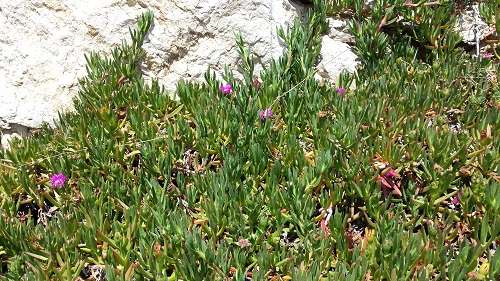Tracking exotic plants' invading strategies in new territories

Growing up and dying, in constant and repeated cycles, is a key strategy for the success of the plant Carpobrotus edulis, an exotic and invasive species around the world, which invades new territories without leaving any other vegetal plants left.
This is the innovative hypotheses of a study, reported in Trends in Plant Science, led by Sergi Munné Bosch, tenured lecturer at the Department of Evolutionary Biology, Ecology and Environmental Sciences of the UB.
The plant Carpobrotus edulis, originally from South Africa, is an exotic and invasive species distributed around several continents. In the Iberian Peninsula, it is provoking a big environmental impact on dunes, sandy areas and cliffs in the Cantabrian coast (Asturias, the Basquelands, and Galicia), the Mediterranean sea (Costa Brava, Delta de l'Ebre, Menorca) and the South Atlantic. This plant multiplies quickly if not controlled, which makes it difficult for native species to regenerate. It also contributes to the progress of other invasive species.
Why are some exotic species invasive?
There are currently a lot of doubts about the implied mechanisms in the plant world biological invasions. Some invasive species as aggressive as Carpobrotus edulis show clonal growth, which means there is reproduction without seeds, which can contribute to the invasive ability of the plants. Clonal reproduction, expanded in plant taxonomy, creates a series of ramets that are genetically identical and can survive both independently and connected.
The researcher says, "The clonal propagation allows colonizing new places in a fast way, competing efficiently for the light and occupying other native species' places. And if the invasive plants are well adapted to the new environment they occupy, they can become a great threat for the native plants. The clonal growth makes this process much easier."
The clonal plants are shown as cooperative biological systems with a high ability of colonizing new environments. They control lots of vegetal communities and are frequently found in habitats of extreme environmental conditions. "From an evolutionary perspective, cloning is less efficient than sexual reproduction. However, when sexual and asexual reproduction combine, the invasive species can cause, as in C. edulis's case, a great environmental impact on the natural habit," says Bosch.
Clones and biological invasions: an evolutionary success
The repetitive "grow and die" strategy would be a decisive factor for the success of the clonal invasive plants like C. edulis, say the authors. "While some clones grow and asexually reproduce themselves to gain territory, others die in a controlled way (after reproducing) and allow the growth of the same species but not others, in a process known as auto-facilitation. As a result of this process, the conditions of the ground are altered and other species cannot grow there," the authors report.
"Senescence, which is a kind of programmed cell death, is also part of the process. In a controlled way, the reproductive sprouts die. Therefore, the same death is an active process and a key factor for the invasive process. Moreover, the clonal reproduction can generate variability, and therefore, a greater adaptive potential thanks to the epigenetic changes, which ease a fast adaptation of these species in the new place they occupy."
A threatening future for the plant biodiversity
In this threatened context for the global environment, it will be essential to know the biological mechanisms that promote the invasiveness of many plant species. "Some of these species, such as Carpobrotus edulis or Aptenia cordifolia, are found in our gardens. Without any doubt, these organisms can contribute to an important loss of the current biodiversity and are a threat if we want to keep our natural ecosystems as they are now," warns Munné.
In order to face future challenges protecting biodiversity, Professor Sergi Munné Bosch leads a team in the UB that promotes research projects on eco-physiology and agrobiotechnology, with special emphasis on the antioxidants (vitamin E and C, and flavonoids), plant aging and senescence, and resistance mechanisms against external factors (water stress, salinity, etc.) and photo-protection.
More information: Erola Fenollosa et al. Death and Plasticity in Clones Influence Invasion Success, Trends in Plant Science (2016). DOI: 10.1016/j.tplants.2016.05.002
Journal information: Trends in Plant Science
Provided by University of Barcelona




















